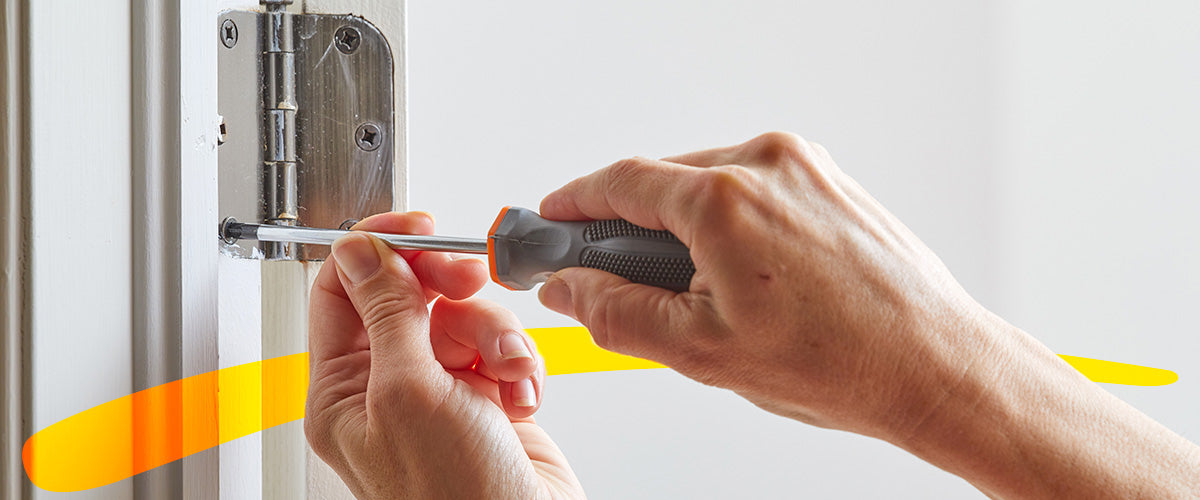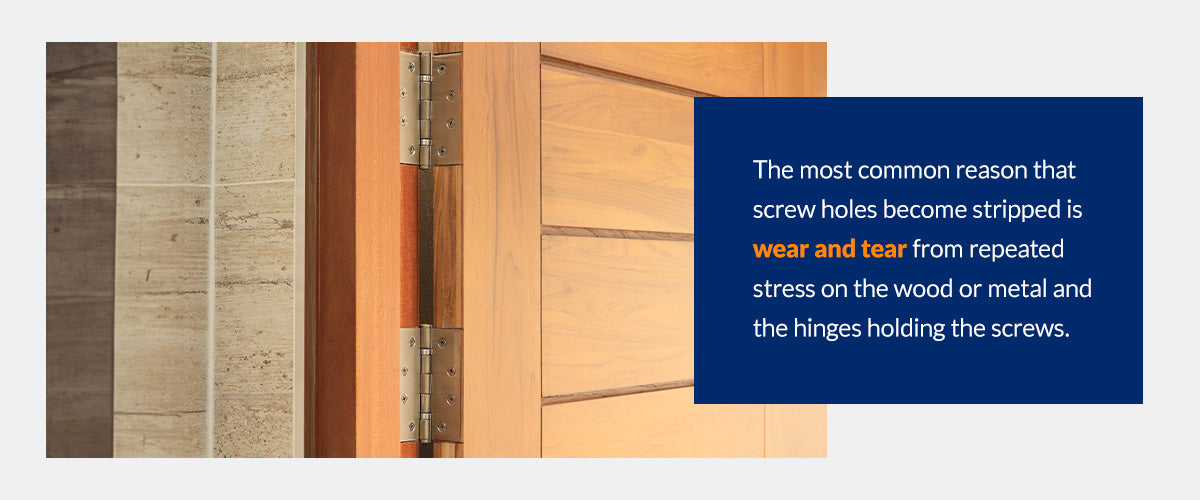
Have you noticed a door that feels loose at the hinges? The screws and the holes they’re drilled into may be stripped. By stripped, we mean that the drilled holes and screws are unable to efficiently hold the weight of the door. This can create wear on the door jamb and cause the door to improperly shut, so the screws don’t fit snugly anymore. What should you do about this problem?
Luckily, it can be a relatively cost-effective and easy fix! Here is a step-by-step guide for fixing a stripped screw hole for hinges.

Causes of Stripped Screw Holes
The most common reason that screw holes become stripped is wear and tear from repeated stress on the wood or metal and the hinges holding the screws. This is a natural consequence of repeatedly opening and closing doors. Other causes of a stripped screw hole include:
- Putting too much weight on the screw.
- Expansion and contraction of the wood from weather changes.
- Drilling or turning the screws at an angle to the door frame.
- Overtightening screws.
Sometimes, the issue also lies in opting to use electric tools to drill in the screws. To prevent screw holes from becoming stripped as you install screws, you need need to work with the drill at the appropriate rotational speed. However, some drills don’t have a speed setting and will drive the screw in too quickly, which can strip the wood. If you don’t have speed settings on your drill, the most effective method is to start with an electric drill but finish the final torque manually. Installing screws manually will give you some control over the torque required to secure the screws.
If you do choose to drill, there are some tips you can apply to avoid stripping, including choosing a drill with a range of speed or torque settings, matching the right drill bit to the screws you are using for optimal torque, and drilling pilot holes sized to the screw shank diameter.

Methods to Fix a Stripped Screw Hole
You can fix stripped screw holes using a variety of methods depending on the resources at hand.
Order a Screw Repair Kit
Screw repair kits are easy to find at local hardware stores, or you can order one online from woodworking retailers. Screw repair kits are an excellent option if you want a straightforward and easy method. Kits come with a plastic strip fitting and glue. To use these repair kits, you typically cut the strips to the size you need so that they fit to the correct depth of the threaded hole. If the kit comes with glue, you use the glue to secure the plastic anchor.
Some kits are suited for specific materials, but many work with any type of material. Screw repair kits are convenient for simple projects, but they may not fit all applications.
Try Larger Screws
Stripped screw holes can’t secure screws anymore because the thread engagement is no longer effective in the enlarged hole.
For wood, an easy fix can be replacing the old screw with a longer screw and one that has a slightly larger diameter. However, a larger diameter means a larger head, which may cause binding when the door is closed. You may be able to install a larger screw into the stripped hole securely enough for a temporary fix. Note that this method may not work for hinges installed in metal frames.
Be careful of using a screw that is too big for the hole — or applying too much force as you drive it in — or it may split the wood as you install it. Opt for a screw that is only bigger by a gauge or two to avoid damaging the hole.
Insert Matchsticks or Toothpicks
A quick way of tightening a screw hole that’s become too long is to fill it with matchsticks or some sturdy toothpicks. Filling the hole with matchsticks is a good way to fix door hinge holes if you are working with frames that are made of softer wood. Simply gather a few matchsticks with the same width and place them into the hole before driving the screws in. Where applicable, you can add a small amount of wood glue to the hole before placing the matchsticks.
Fill the Hole With Hardwood Dowels
To fix cabinet hinge holes, you can use dowels to fill the hole before you install the screw again. Filling holes and re-installing screws is one of the most effective and secure methods. This method also suits applications where the frame is made from harder wood that can break or tear more easily. Filling the hole using dowels is also a better choice if you have a heavy door.
Use DIY Techniques to Fill the Hole
If you are really in a pinch, here are a few innovative methods to fix stripped screw holes by using everyday items:
- Use cable ties to fill the hole.
- Use insulated wire casing stripped from the wire.
- Fill the hole with glue, and allow the glue to dry fully before placing screws.
- Plug the hole with tissue paper and glue, trim the excess, and allow the glue to dry before driving in the screws.

How to Fix a Stripped Screw Hole
Filling a stripped screw hole and re-installing the screw can provide a secure fix that can last longer than other DIY methods. Here is an overview of what you will need, and step-by-step instructions to guide you through the process.
Here’s what you’ll need:
- A screwdriver
- A power drill
- A drill bit
- A wooden dowel (should be the same size as the drill bit)
- Wood saw (handheld or mechanical)
- Wood glue (preferably Gorilla Glue)
- New screws
Follow these 5 steps to fix a stripped screw hole:
1. Remove the Old Screws From the Door Hinge
Depending on how stripped the holes are, the screws may easily pull out. Otherwise, screw them out and discard them. You can leave the hinge attached to the door if those holes are in good condition. If not, remove those too. Unless your door has three hinges, you’ll need to pop the pins of the hinge to remove the door.
2. Size the Dowel
Before drilling any holes, you want to make sure that the size of the hole is going to match the diameter of your hardwood dowels. You will need to cut the dowel to fit the depth of the threaded hole. To do this, insert the dowel into the first hole and measure how far it goes in with a pencil. Pull it out and cut it with a saw into a small bit. It will likely measure around 1 inch in length. You’ll do the rest of the holes just like this, so you end up with a bunch of little dowel pieces.
3. Drill out Holes and Place Dowels
Next, you’ll take your power drill to clean up the existing hole and prepare it for the wooden dowel. Take a little wood glue and put it on the base of the hardwood dowel, then fit it into the hole. We recommend that you use Gorilla Glue, as it does a great job of expanding in the hole.
Drive the dowel in by lightly hammering. Trim off any excess, then sand the plug or dowel down so that it is flush with the frame.
4. Pre-Drill the Holes and Install the New Screws
Allow the glue to cure based on the manufacturer’s recommendations, then drill a pilot hole in the center of the dowel before installing a new screw. You can mark the wood through the openings in the hinge for accuracy. Line the hinge back up with the holes and start the new screws. The important thing to remember here is to not overtighten! You’ll just end up stripping the hole again. Get the screws just tight enough with the screwdriver to where the hinge doesn’t budge.
5. Finish Up
Repeat this process for all the hinges to fully repair the stripped holes. You should end up with a very sturdy result! This repair will also work for striker plates.
Tips for Preventing Stripped Screw Holes
Follow these tips to prevent common door hinge issues like stripped holes:
- Drill pilot holes to prevent the wood from splitting when you install screws.
- Avoid overtightening screws.
- Use the right torque setting on your drill.
- Use the right drill bit sizes and screw sizes for the application.
- Opt for high-quality materials, including your hinges and screws, so they last longer.

Source Quality Hinges From HardwareSource
While fixing your stripped screw holes, you may wish to go ahead and replace your door hinges to add new, modern accents or to match your home’s color scheme. At HardwareSource, we offer hundreds of beautiful door hinges in a variety of styles and finishes. We have everything from traditional and modern styles to European and beyond.
Whether you need butt, spring, or heavy-duty hinges, we have them! We also carry a wide range of screws, so you can get the perfectly matching ones for your new hinges. It’ll be easy to find the right measurements and, best of all, we ship the next business day. Whether you’re a contractor, homebuilder, or homeowner, we’re your source for high-quality hardware at an affordable price. Browse our collection of hinges and screws or use our convenient Hinge Finder to get exactly what you need.
